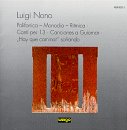| All Artists: Nono, Luz, Hirsch, Ensemble United Berlin Title: Polifonica-Monodia-Ritmica Canti per 13 Canciones a Guiomar Members Wishing: 3 Total Copies: 0 Label: Wergo Germany Release Date: 11/24/1998 Genres: Pop, Classical Styles: Vocal Pop, Chamber Music, Symphonies Number of Discs: 1 SwapaCD Credits: 1 UPCs: 713746112226, 4010228663129 |
Search - Nono, Luz, Hirsch :: Polifonica-Monodia-Ritmica Canti per 13 Canciones a Guiomar
 | Nono, Luz, Hirsch Polifonica-Monodia-Ritmica Canti per 13 Canciones a Guiomar Genres: Pop, Classical
Collecting two 1950s-era works, one composition from the early 1960s, and a final, extended work from 1989, this CD brilliantly captures Luigi Nono's meditations on form, silence, and tone. Ensemble United Berlin's perform... more » |
Larger Image |

 Track Listings (6) - Disc #1
Track Listings (6) - Disc #1
